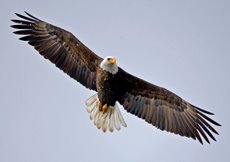AUTHORS
Julie Beckstead1,3, Alexandra N. Lagasse1, and Scott R. Robinson2
1 - Department of Biology, Gonzaga University, Spokane WA, 99258
2 - Wildlife Biologist, Retired, Bureau of Land Management Coeur d'Alene Field Office, Coeur d’Alene, ID 83815
3 - Corresponding Author: Julie Beckstead (beckstead@gonzaga.edu)
THE ECOLOGICAL QUESTION
How does a bald eagle population change over time at a winter migratory stopover and which factors influence its abundance?
ECOLOGICAL CONTENT
Bald eagle biology, conservation biology, endangered species, population ecology, and migration ecology (stopover)
WHAT STUDENTS DO
Guided Approach: Students will generate questions about bald eagle numbers influenced by weather and food availability. Students will then use graphing software (JMP or Excel) to compile the data in a graphical form to answer their questions.
Open-ended Approach: Students will generate their own hypotheses of interest from the larger bald eagle data set. This approach is encouraged for upper division ecology students in conservation biology, wildlife management, or population ecology classes.
Optional: Field trip to see migrating bald eagles.
SKILLS
Generation of a hypothesis, critical thinking, experimental design, data management using a spreadsheet, graph preparation, data analysis and interpretation, and/or written or oral presentation.
STUDENT-ACTIVE APPROACHES
Brainstorming, critical thinking, concept mapping, cooperative learning, guided inquiry, and/or open-ended inquiry
ASSESSABLE OUTCOMES
Proposal of research, figures from spreadsheet data, written interpretation of data, short or full research reports, and/or oral reports
SOURCE
U.S. Department of the Interior, Bureau of Land Management, Coeur d'Alene Field Office, archived data.
DOWNLOADS
- Full Article Text [doc], [pdf]
- Student Data Guided Approach: Contains a subset of the data for students to use in the guided approach. [xls]
- Student Data Open-ended Approach: contains all data for students to reference and use at will. [xls]
- Student Research Proposal and Glossary: contains the elements of the scientific process and experimental design to guide students in the activity. Also included is a glossary of associated terms. [doc]
- Faculty Experiments for Guided Approach: Table 1 that includes the scientific process and experimental design for the three experiments described in the guided approach. [doc]
- Faculty Data Analysis for Guided Approach: contains graphed data and data analysis for the three guided approach questions. [doc]
- Faculty Sample Experiments for Open-ended Approach: Table 2 that includes the scientific process and experimental design for five possible student experiments. [doc]
- Student Graph Rubric for Guided Approach: contains a rubric to aid in grading student created graphs and answers to discussion questions. [doc]
- Student Short Checklist for Guided Approach: contains an example of an assessment tool for a short report. [doc]
- Student Full Checklist for Open-ended Approach: contains an example of an assessment tool for a full research report. [doc]
Description of Excel Files:
Description of other Resource Files (Files with “Student” in the title are meant for student use and files with “Faculty” in the title are meant ONLY for faculty use):
ACKNOWLEDGMENTS
This data set was developed for Biology 323, Conservation Biology, at Gonzaga University and was improved by input from students in that course. We would like to thank Joe Lint for the initiation and creation of this bald eagle survey; Bureau of Land Management (BLM) employees and volunteers, Lew Brown, Terry Kincaid, and Corinne Cameron, for their years of bald eagle data collection; BLM Coeur d’Alene Field Office for the funding that made these data collections possible; Idaho Fish and Game for kokanee salmon data; Elizabeth Bart and Scott McCloskey for initial teaching ideas; Tracy Morgan for the creation of the survey site map; Ann-Scott Ettinger for aid in developing the checklist assessment tool; Carol K. Augspurger for use of the research proposal and glossary; and Ed Dole, Sheila Lyons-Sobaski, Jennifer Rubin and three anonymous reviewers for helpful comments on previous drafts.
CITATION
Julie Beckstead, Alexandra N. Lagasse, and Scott R. Robinson. February 2011, posting date. Exploring the population dynamics of wintering bald eagles through long-term dataTeaching Issues and Experiments in Ecology, Vol. 7: Practice #1 [online]. http://tiee.esa.org/vol/v7/issues/data_sets/beckstead/abstract.html
